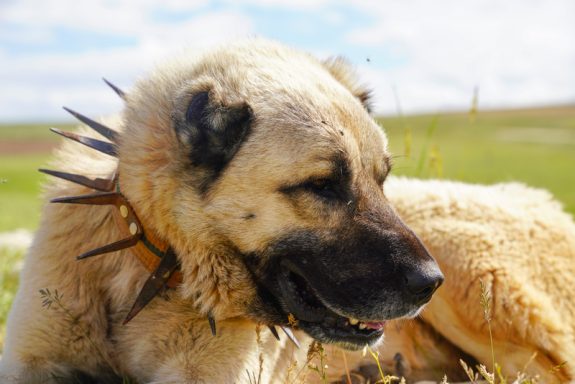
Prong collars are frequently misunderstood by the “lay person.” They look scary, sharp, and cruel to the dog wearing one, but this post isn’t about the pros and cons of prong collars – the internet is filled with articles on the topic (and this is one of them). We mention them as a segue to the traditional role of the spiked collar in Turkey, and particularly with the Anatolian Shepherd.
It may offend the sensibility of today’s dog owner, but yesterday’s Turkey was not a place for weak dogs. There weren’t breeding programs as we know them in the modern sense, but Turkish farmers nevertheless had their own way to produce superior dogs, and by superior, we mean dogs that could do their job. Oral traditions suggest that a young Anatolian was required to demonstrate his natural ability to pick up on the presence of a wolf, outrun or catch it, and dispatch it on a one-to-one basis. Only when the dog was proven did it earn the privilege of wearing a wrought iron, spiked collar. The presence of such a collar was a visible sign that the dog was worthy of wearing it, that he or she had earned the right to wear it.
Some sources, however, hint that this legend isn’t necessarily accurate. Fencing wasn’t common on Turkish farms, nor could a farmer afford to feed many dogs. A Turk was also barred from owning a long gun, so a dog had to earn its keep by protecting livestock, keeping feral pigs and bears off crops, and basically serving as a 24 hour security guard. A good protection dog proved his value more subtly by the evidence of a conspicuous absence of predator losses. It’s entirely possible that such collars were specially made for particularly favorite dogs which supported the stories of legendary dogs earning these collars.
That said, we came across an anecdote which nicely illustrates the point that a spike collar wasn’t just a symbol of the dog’s worth to Turkish people, it was also a detectable sign to other dogs that going after the throat of a potential competitor wasn’t going to be all that easy.
A soldier sent to Turkey on assignment acquired an Anatolian Shepherd for his family, a dog they named “Zorba.” Having seen spiked collars on some other Anatolians, the soldier bought one for Zorba to protect him from boars he occasionally hunted. During one such hunting trip, the Turkish man with whom he was hunting advised the soldier to put Zorba in the car immediately when he spotted six strange dogs on a hill that were headed straight for them at a rapid pace.
Curious at the chap’s reaction, the lieutenant pointed out that the approaching dogs were the same breed, foolishly assuming that the dogs wouldn’t harm one of their own. The Turk explained to the soldier that his dog was a stranger in the area, and that the other dogs could very well kill him. Upon hearing this, the soldier retrieved Zorba’s spiked collar from the car to put it on his dog, and this calmed his Turkish friend. The Turk had assumed the soldier was a tourist who didn’t know the significance of the collar.
As the six dogs got closer, they slowed their pace, sniffed the air, and eventually wandered off. Why no fight? the soldier asked. His companion answered that the collar had averted a kinetic confrontation between the dogs. Whether this was true is difficult to say. The soldier’s dog was younger, larger, and better fed than the other dogs, but perhaps centuries of tradition had imprinted upon the dogs the meaning of a spiked collar on sight. Who can say.
What’s certain is that one doesn’t want to stand too close to a dog wearing one. In some cases, the spikes have been chiseled to fine points at the ends by a Turkish blacksmith, and the spikes on some collars are three inches long! Different regions of Turkey have collar styles unique to the areas, and, of course, the collars owe much to the individual style and skill of the smithy, as well as the quality of materials he has at hand. In some poorer areas, even wood has been used to fashion spike collars.
Today, such collars are usually saved for educational exhibits or even as wall hangings, though in rural areas, one might still see one on a dog.
Interested in more information about this breed? Check out an earlier article below:
Image: Anatolian Shepherd by ©Bilal Kocabas/Dreamstime.com
